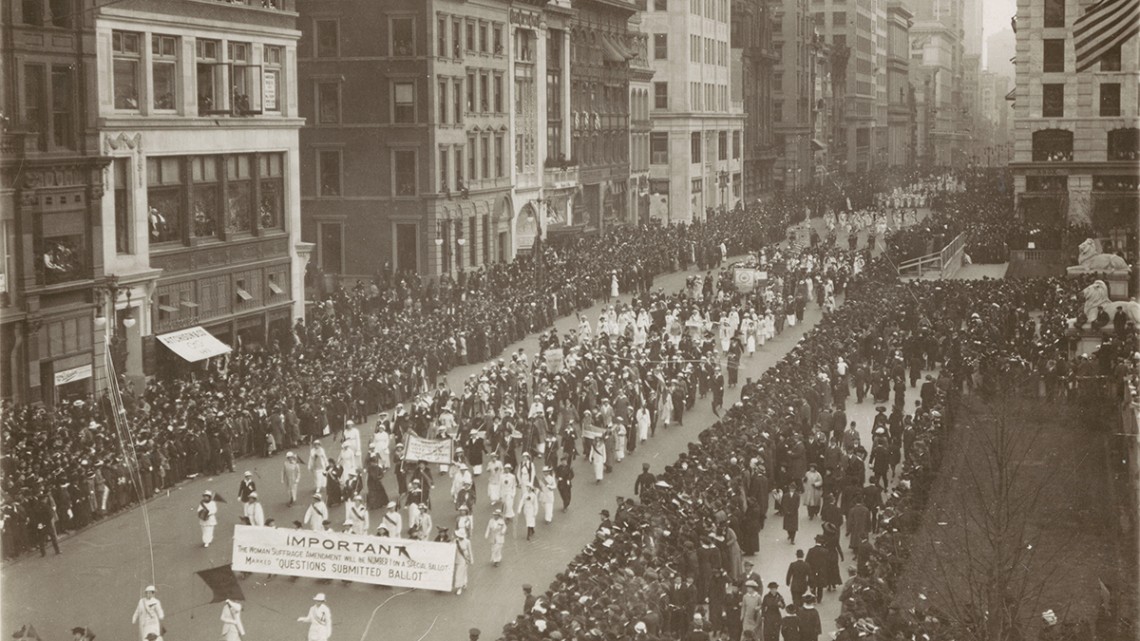
A 1915 suffrage march in Manhattan.
Exhibit, talk celebrate 100 years of women voting in New York
By Melanie Lefkowitz
When New York state voters gave women the right to vote on Nov. 6, 1917 – three years before the 19th Amendment granted the same right nationwide – activists on campus and around the world had been working toward the goal for decades.
To celebrate New York’s suffrage centennial, rare photographs, letters, programs and other memorabilia documenting the movement from Cornell University Library’s Division of Rare and Manuscript Collections (RMC) will be on display in Kroch Library’s reference room beginning Nov. 3.
On Nov. 9, former University Archivist Elaine Engst and Tompkins County Historian Carol Kammen will give a talk on suffrage efforts in Ithaca and at Cornell at 4 p.m. in 160 Mann Library. From Nov. 2 to March, Mann will also feature an exhibit in its lobby, with reproductions of correspondence between Martha Van Rensselaer, co-founder of the College of Human Ecology, and suffragist Carrie Chapman Catt, as well as pamphlets and broadsides for and against women’s voting rights.
“We wanted to show, through these artifacts, how the suffrage movement played out in the public sphere and in everyday lives,” said Eileen Keating, university records manager and archivist for the College of Human Ecology, who is co-curating the Kroch suffrage exhibit.
Among the items that will be on display in Kroch are a photograph of a 1915 suffrage march through Manhattan and a fan printed with the words, “Keep Cool! There will be nothing to worry about after we get Votes for Women.”
Items also cast light on how suffrage affected Cornell. By 1917, around 14 percent of Cornell students were women, but in the 19th century there were far fewer, and most undergraduates then opposed suffrage. A suffrage petition in the university library in 1894 garnered around 100 signatures.
Also in 1894, the New York State Woman Suffrage Association held its annual convention in Ithaca, and participants were welcomed by Cornell President Jacob Gould Schurman. A program from a 1914 suffrage conference, part of the Homemaker’s Conference at Cornell’s Farm and Home Week, shows that Schurman introduced Catt’s speech in Sibley Dome, and Helen Magill White, wife of Andrew D. White, hosted a reception for Catt one evening at the president’s house.
In a 1905 letter to Van Rensselaer, Susan B. Anthony writes, “there is now a Suffrage Society in Ithaca, to which I presume, you belong. I hope to hear a good word from it.” She also asked if Van Rensselaer knew Nora Stanton Blatch, Class of 1905, the granddaughter and daughter of suffragists Elizabeth Cady Stanton and Harriot Stanton Blatch, who became the first woman in the United States to earn a degree in civil engineering.
“Many Cornell women were involved in the suffrage movement locally, in New York state, and nationally,” Engst said. “President Schurman was also very important – by 1917 he was a major speaker in support of suffrage.”
In addition to artifacts about suffrage in New York state, RMC is home to the Lindseth Collection of American Woman Suffrage. It includes hundreds of materials documenting the suffrage movements across the United States and in Europe, from medals awarded to women after hunger strikes in jail to postcards, ribbons and programs from suffrage events.
Melanie Lefkowitz is staff writer, editor and social media coordinator for Cornell University Library.
Media Contact
Get Cornell news delivered right to your inbox.
Subscribe